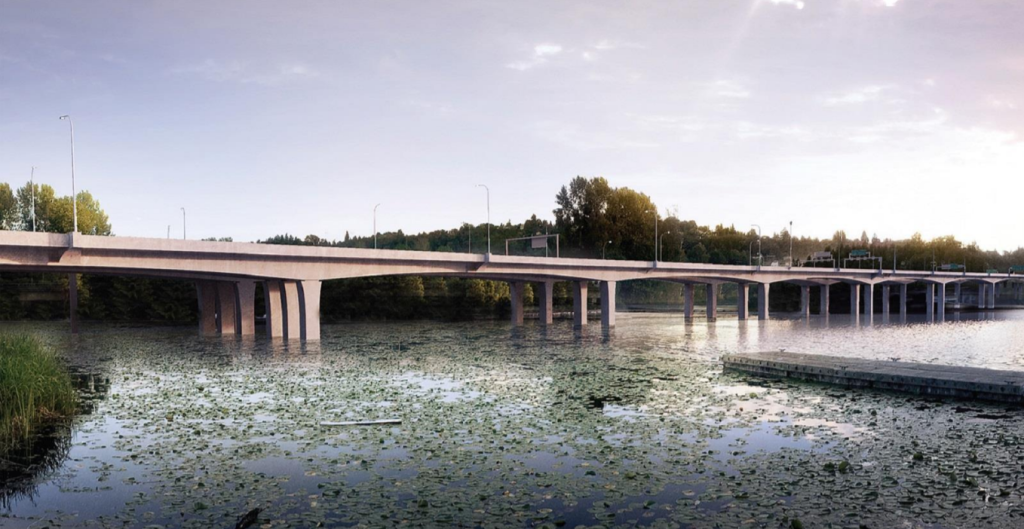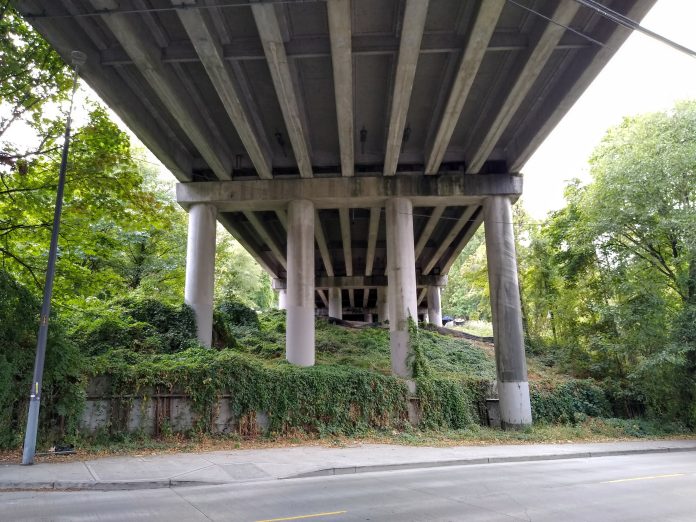
As Governor Jay Inslee proposes a dramatic increase in state subsidies for electric vehicles in Washington State in his supplemental 2022 budget update, his proposed budget for the Washington State Department of Transportation (WSDOT) also includes funding to fill in a number of large budget holes on some of the Puget Sound region’s largest megaprojects. These budget holes, adding up to nearly $1 billion in total, have been widening as increased costs impact nearly every project in the transportation sector and project delays due to the pandemic have added costs on top of that.
The transportation budget also represents the first official announcement of how the Inslee administration will seek to utilize funding from the federal Infrastructure Investment and Jobs Act (IIJA), commonly referred to as the Bipartisan Infrastructure Law. That law is expected to add about $200 million dollars per year to WSDOT’s existing budget, and Inslee’s budget proposes to use the lion’s share of that money for 2022 to bail out highway projects that the legislature already approved in its Connecting Washington package in 2015. Out of $289 million from the IIJA, $80 million would be directed to preservation projects to maintain current infrastructure, with the remainder allocated to these in-progress highway “improvement” programs.
The size of the funding gaps being filled in Inslee’s proposed budget are larger than even current funding levels for key programs in WSDOT’s budget like public transportation and active transportation. This comes despite a push from advocates, and even the United States Department of Transportation, for states to not utilize IIJA funding for highway expansion, and instead to invest in expanding transit, biking, and walking infrastructure.
If the states fail to prioritize transit and active transportation, the consequences could be disastrous. A new study by the Georgetown Climate Center noted that “if investments instead flow mostly to adding more lanes and building more roads, the IIJA funding could result in an increase in emissions over what we’d expect without this additional investment.” Backfilling existing projects could prove an easy decision for Washington’s climate governor, even as his legislature contemplates a slew of new highway projects that could be funded by a new transportation package.
SR-520
Inslee’s budget proposes an additional $400 million for the Seattle end of the SR-520 replacement project. With work more than halfway done on the new highway lid and nine-lane boulevard in Montlake, a funding gap remains for the portion to the west. That total funding gap as of this year, due to increased costs impacting nearly all transportation projects, an overall delay in the project’s timeline, and changes in the project’s scope, is $600 million. Those scope changes, following a community engagement process in 2019, include a switch from one large replacement bridge over Portage Bay to two bridges, one carrying traffic in each direction, with a fully connected shared use trail that hadn’t been included in the original cost estimates. A number of improvements to bike and pedestrian connectivity around the bridge and lid have been added.
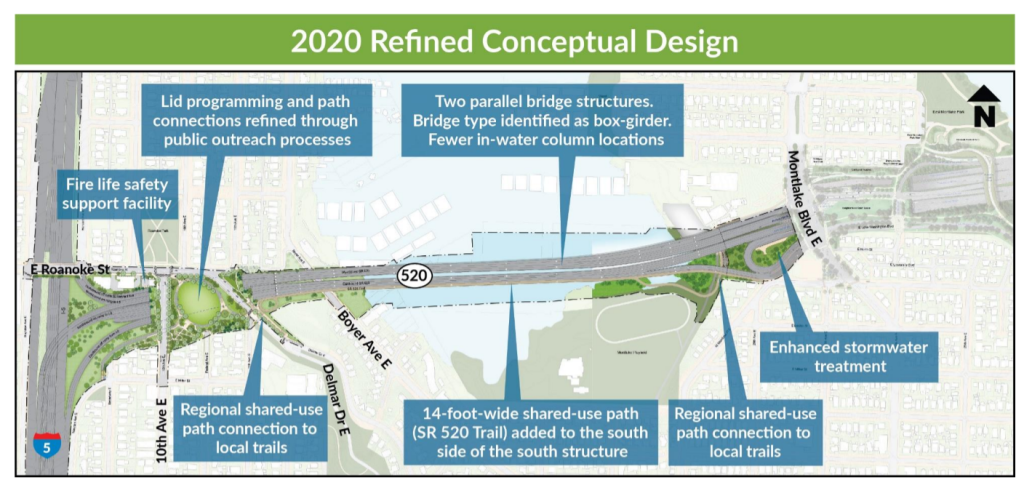
That $600 million gap also assumes the completion of a second bascule bridge over the Montlake cut. Building that second bridge isn’t supported by the City of Seattle, where a council resolution passed in 2015 stated that “[Seattle] continues to support the position that improvements made by a second Montlake bascule bridge are unlikely to yield the benefits that justify the cost and environmental impact of a bridge.” An attempt to change that position to supporting a bridge if it didn’t add additional vehicle capacity was made in 2019 by interim District 4 Councilmember Abel Pacheco but was not successful. State Senator Jamie Pedersen, representing the 43rd District which includes Montlake, has stated he supports allocating the funding for a second bridge elsewhere.
With a second bridge dropped from the project, that additional $400 million should be enough to finish the entire SR-520 project as designed, which also includes new express lanes for transit between SR-520 and I-5 at Mercer Street, currently under construction and set to open to buses in 2023.
I-405 and SR-167 Projects
The Governor’s budget also includes a proposal to allocate $450 million to a suite of projects along the I-405 and SR-167 corridor between Lynnwood and Puyallup. Broadly, the overall program will add express toll lanes (ETLs) to most of the corridor. The projects would also add infrastructure to accommodate Sound Transit’s I-405 Bus Rapid Transit project, called Stride, which will run between Lynnwood and Burien, and should decrease overall bus travel times. Sound Transit is on track to open two of its three Stride lines in 2026, with the third opening a year later. But the budget gaps impacting the overall program could endanger that timeline.
Legislators need to act fast in order to enable to WSDOT to keep a key project integral to Stride on track: the project to add express lanes on I-405 between SR-527 and SR-522 in Bothell. In order to complete the project by 2026, WSDOT needs a “commitment” from the Governor and the Legislature (presumably the chair of each house’s transportation committee) by next month, with legislation passed by the end of the session in March.
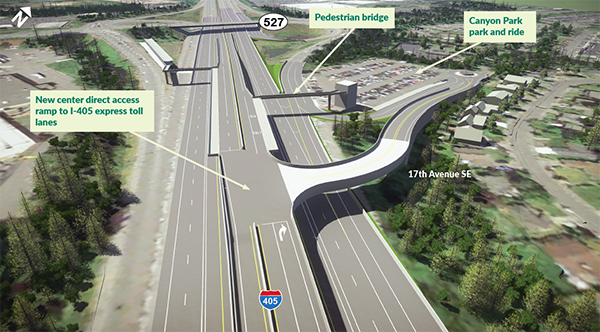
The $450 million is the amount needed to keep everything on track. WSDOT did come up with an alternative that would have delayed some projects by a full decade and prioritized others that would generate toll revenue to pay for additional elements, but local elected officials along the corridor, not surprisingly, are not eager to sign on to delays.
“The Governor’s budget has identified $450 million of funding from sources that would not impact the rest of the department’s budget, relying primarily on additional funding available from the federal response to the pandemic ($300 million). The Governor also is proposing to defer sales taxes on these projects and access other available transportation funds to fill in the gap,” WSDOT Program Adminstrator Omar Jepperson told me.
Earlier this year, The Urbanist reported on a possible reaction that Sound Transit could have to increased costs on its portion of the I-405 project: cutting pedestrian access. Sound Transit, in contrast with WSDOT, cannot lobby local elected officials to ask the state legislature for more money to complete its projects on time and without sacrificing project elements.
Puget Sound Gateway
The Puget Sound Gateway projects, also known as the SR-509 and SR-167 “completion” projects, do not see an additional allocation of funding in Inslee’s proposed 2022 budget. WSDOT recently awarded a $376 million contract to build a new 2 mile segment of SR-509 between I-5 and the Port of Tacoma. But the latest update on the pair of highway extensions is that they require an additional $382 million to complete as they’re currently envisioned.
With the projects above being prioritized with this round of federal infrastructure dollars, the gap on the Gateway projects is one to watch in the next few years. According to WSDOT, the legislature needs to allocate funding to fill that gap by the end of the 2023 legislative session in order to not impact the project’s schedule: the next round of anticipated IIJA funding would likely close most of that gap.

Inslee’s budget, as was noted in Doug Trumm’s article for The Urbanist earlier this month, includes a proposal to spend $7.2 million from the federal infrastructure bill’s Carbon Reduction Program on state trails and “bikeways.” Washington is set to get over $21 million from that Carbon Reduction Program in 2022, but we don’t yet know what the remainder will be spent on; the funding can be utilized for anything from upgrades to make streetlights more efficient to public transit infrastructure.
It also proposes allocating an additional $30 million to WSDOT’s Bicycle and Pedestrian grant program and $15 million to its Safe Routes to Schools grant program. Those programs are currently able to dole out just a fraction of the amounts requested by cities and towns across the state. But that new funding, along with $30 million in Special Needs Transit Grants, $10 million in general transit grants, and $33 million in decarbonizing grants to transit agencies, is slated to come from proceeds from Washington’s new Climate Commitment Act (CCA), and would only be unlocked if the Department of Ecology brings forth additional legislation on how that program is to be implemented. If that doesn’t happen by April 1, 2023, the funding would expire. The Governor vetoed legislative language that would have tied implementation of the CCA to the passage of a transportation package, but lawmakers are now suing over that veto. A transportation package passing during the 2022 session would be a heavy lift, but could happen by 2023.
If the timeline is not delayed, either by the courts or by the legislature, that funding is expected to bring in $127 million in funding to decarbonize the transportation sector in just the first six months of fund collection, the second half of 2023. By 2027, the total collected is currently forecast to be nearly $1.4 billion. Until that funding materializes, it looks like Washington’s governor is content to continue with the status quo.
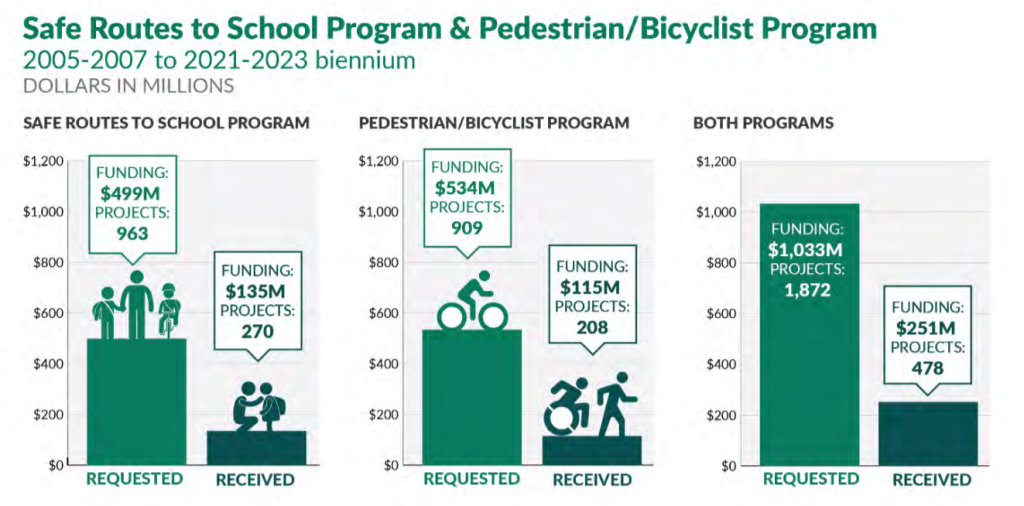
It’s worth noting that any one of these funding gaps listed are more dollars than have been allocated to the Safe Routes to School and Bike and Pedestrian grant programs combined since 2005 ($251 million) even as localities have requested over $1 billion in funding to make urgent safety improvements that would enable residents to get around safely by walking or rolling. The orders of magnitude difference is a stark illustration of how Governor Inslee and the state legislature prioritize transportation dollars.
Ryan Packer has been writing for The Urbanist since 2015, and currently reports full-time as Contributing Editor. Their beats are transportation, land use, public space, traffic safety, and obscure community meetings. Packer has also reported for other regional outlets including Capitol Hill Seattle, BikePortland, Seattle Met, and PubliCola. They live in the Capitol Hill neighborhood of Seattle.


